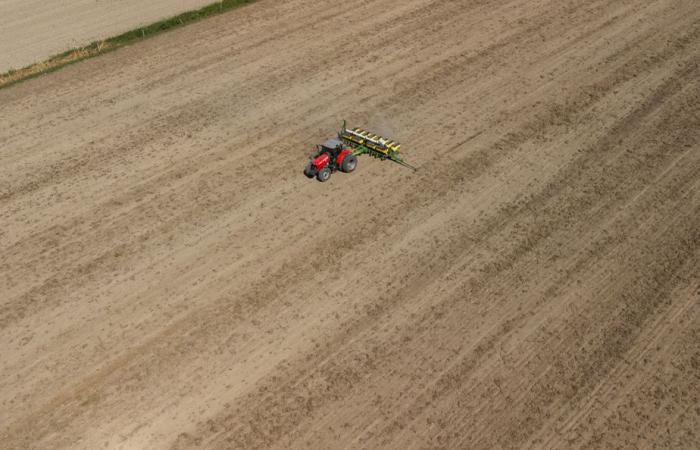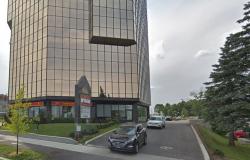The surface area of Quebec’s agricultural land continues to decrease, but contrary to what one might believe, the majority of the losses are not attributable to human activity, but rather to the abandonment of crops in favor of forests. , a phenomenon that the Institute of Statistics of Quebec (ISQ) calls enrichment.
Published at 10:45 a.m.
Pierre Saint-Arnaud
The Canadian Press
The Institute published this week the results of analyzes of the evolution of cultivated areas of six regions between the decade of 2000 to 2010 and that of 2010 to 2020. These analyzes are added to those of six other regions published last year. last, so that an overall picture begins to take shape.
The publication, titled Southern Quebec land accounts 2024therefore adds the data from the regions of Estrie, Montreal, Laval, Lanaudière, Laurentides and Montérégie to those revealed last year (Capitale-Nationale, Chaudière-Appalaches, Bas-Saint-Laurent, Gaspésie–Îles- de-la-Madeleine, Abitibi-Témiscamingue and Outaouais).
More abandonment than transformation
The observation is that the artificialization of land, that is to say a transformation into space dedicated to human activity – housing, industry and commerce, transport infrastructure, vacations, in particular – continues to grow, but the greatest Part of the loss, by far, is abandonment to land use.
In fact, around 80% of agricultural land loss is due to encroachment and the rest is attributable to land take.
Sarah Roy-Milliard, one of the main researchers and authors of the work Southern Quebec land accounts 2024
“The artificialization of agricultural land, however, has increased slightly, according to the preliminary data we have for all of Quebec. But it is indeed encroachment which is the primary cause of loss of agricultural land. These are lands that cease to be cultivated. This is an observation that surprised us,” she admits.
Artificialization on the urban periphery
It is the immensity of the Quebec territory which tips the scales, it is specified, because land cover weighs more in the regions than in the urban periphery, where artificialization is more marked.
For example, Estrie lost 87 square kilometers (km2) of agricultural land between the decade 2000 to 2010 and that of 2010 to 2020, but only 14 km2 have been artificialized, the rest, 73 km2returned to the wild. On the other hand, Lanaudière lost 26 km2 of agricultural land, but it is 22 km2or 84.6%, which have been artificialized.
In the Laurentians, almost half of the 36 km2 of lost agricultural land, i.e. 17 km2have been artificialized, a finding similar to that of Montérégie, where 33 of the 75 km2 of lost cultivated land has also been transformed to meet the needs of human activities.
Some will be surprised to learn that there are still 6 km2 of agricultural land on the island of Montreal, but it is still a loss of 2 km2 half of which have been artificialized. In fact, 72% of the Island’s surface area is artificial. Laval, which had experienced the highest rate of artificialization of its territory in the previous decade, saw this loss slowed down, but Île Jésus still suffered a loss of 5 km2 of agricultural land and an increase of 3 km2 of artificial surface area. Some Laval residents will possibly be surprised to learn that there is always 38 km2 of agricultural land on their territory which is only 57% artificial.
Speculation and gentrification
How can we explain this abandonment of agricultural land to nature? The ISQ has no explanation, its work is limited to carrying out an inventory using a very detailed analysis of aerial and satellite photographs over several years.
The SaluTERRE Alliance, formed in November 2023 by a group of organizations with the precise aim of protecting agricultural land, offers the beginnings of an explanation.
What we observe here is the result of an obvious phenomenon: often, speculators buy land and, without any obligation to cultivate it, leave it abandoned. These wastelands eventually become forests and it becomes more complicated to devote them to agriculture.
Colleen Thorpe, Executive Director of Équiterre, one of the organizations behind the creation of the SaluTERRE Alliance
This explanation is partly true, notes the general director of the Union of Agricultural Producers, Charles-Félix Ross. “What we often hear in the regions is that there are a lot of [d’embourgeoisement] land, that is to say that there is a form of return to the countryside of people who have means. They buy farms with woodlots and do not cultivate. There is a lack of reclamation of these lands. »
“It’s a new phenomenon: owners who own large agricultural areas mainly for vacation reasons, to want to live in the countryside or in rural areas. We want to have a foothold in the countryside, but without having the intention of farming,” he says.
Shocked producers
This phenomenon is observed in Estrie, particularly in the Mont-Orford sector, but also much in the regions of the Capitale-Nationale, more precisely in Charlevoix, and in Chaudière-Appalaches, especially in Beauce.
“I often hear shocked producers who say to themselves “he bought land and he does nothing with it” and we must understand that in Beauce, for example, there is an intensity of animal production and they need the land to spread the manure then the slurry to balance, but these lands must be under cultivation,” explains Mr. Ross.
The UPA, he says, has never quantified the phenomenon, but Mr. Ross says he was “very surprised” by the extent of the land cover. And speculation or gentrification do not explain everything, quite the contrary. In the data made public a year ago, we see a loss of 107 km2 of agricultural land in Chaudière-Appalaches, including 76 km2 returned to land; in Bas-Saint-Laurent, the loss is 105 km2again with a return to the wild of 76 km2while in Abitibi-Témiscamingue, it is 80 km2 of agricultural land that was lost from 2010 to 2020, of which 57 went to rewilding.
Abandoned crops
It is not gentrification or speculation that explains these losses, affirms Charles-Félix Ross.
In Abitibi, there was an abandonment of agriculture. There were people who made beef, there was a lot of lamb. They really had a significant decline in the number of producers and agricultural activity.
Charles-Félix Ross, general director of the Union of Agricultural Producers
These producers have had many financial obstacles over the last few years, he explains, particularly with stabilization insurance programs. “These are people who are leaving production and these lands are not taken over by producers who remain in production. »
“North of Lac-Saint-Jean [région dont les données sont attendues l’an prochain]it’s exactly the same thing. There are lands where you can only make hay for short periods of time. Therefore, it is necessary to maintain animal production activities, such as […] the production of cows and calves. In these regions, it is indeed the decline of agriculture and the inability of existing farmers to buy back and put this land back into production. »
Loss of 12 football fields per day
The fact remains that the artificialization of surfaces in regions such as Montérégie, the Laurentides, Lanaudière or the Capitale-Nationale remains one of the main problems. “Over the last 25 years, we have lost a little more than 60,000 hectares of agricultural land which should have been protected by the law on the protection of agricultural land. 60,000 hectares which have been diverted to public infrastructure, power lines, houses, factories, whatever. It’s the equivalent of 12 football fields per day,” laments the director general of the UPA.
“What we are observing is really a laxity, a lack of rigor in the application of the rules which aim to protect the territory, the resource, the integrity of the agricultural territory. »
If there is good news to be drawn from this data, it is on the forest side, as the ISQ specifies. “Generally speaking, artificial surfaces have mainly increased to the detriment of forests, while agricultural land has decreased due to encroachment. Overall, these combined changes mean that forest areas appear to remain stable or increase. »






